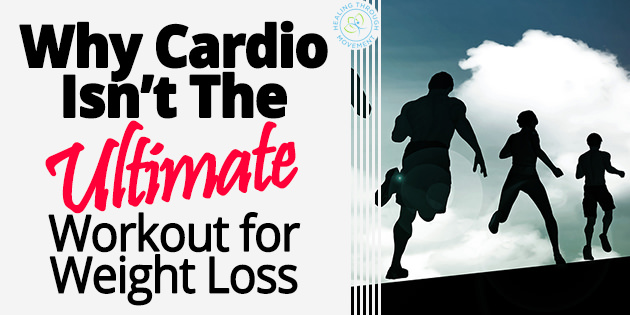A cardio training program should definitely be a part of a weight loss or fitness regimen. Aerobic activities help to burn calories, increase metabolism, improve blood flow, boost the immune system, and maximize oxygen absorption. They make an exciting way to blast calories and extra fat.
However, sticking to a purely cardio program that is free from excess weights can be bad for the body in the long run. Excessive endurance cardio has its disadvantages which can backfire on one’s overall health.
Let’s take a look at some of the drawbacks of relying on an intensive cardio workout:
1. Physical injuries
Some cardio workouts such as running and dancing can put a strain on the joints and the knees. Performing the same activities repeatedly over a long period of time can lead to knee or hip injuries that can be quite painful. The chronic stress imposed on the body can trigger inflammation that may lead to arthritis.
The risk of incurring injuries are higher for certain individuals such as those who may have an existing medical condition or disability, are 40 years of age or above, and have limited training and exercise experience.
2. Overtraining
High-intensity exercises that are performed almost on a daily basis causes the body to be fatigued. When rest periods are not properly integrated, the body is unable to fully recover from the strain of the workout. This leads to burnout and injuries.
It is recommended that aerobic exercises do not exceed 30 minutes per session and that no more than an average of 150 minutes are performed in a week. A common mistake is to overexert the body by running on the treadmill for an hour or two to compensate for days of binge eating or laziness. But doing long hours of steady cardio activities can wreck havoc on the body. It can disrupt the metabolism rate and slow down fat loss.
At least two days of rest is required for the body to fully recover from workout routines. Even athletes who compete professionally give themselves sufficient rest periods to avoid overexertion or overtraining.
3. Insufficient for muscle definition
Cardiovascular activities when done alone, do not shape up the muscles or tone the body. While these exercises can reduce the total amount of body fat, they do not help to form or define the muscles. In fact, prolonged aerobic exercises can break down the muscles.
Lean muscles are critical to burning more calories and forming a sculpted or toned look. This is why weight-bearing activities should be incorporated into a fitness regimen or in a routine such as circuit training which combines aerobic activities, body weights, and light weights.
In addition, adding a strength training routine a few times a week can increase the body’s basal metabolic rate by about 15 percent. This makes it easier to burn fat and achieve a shapely form. It also helps to preserve the muscles and to delay muscle loss that naturally occurs due to aging.
Thus, weight-bearing activities should form an integral component of a fitness program if long-term fat loss is to be achieved.
4. Elevated blood pressure and risks of heart disease
In general, aerobic exercises improve cardiovascular health. While the blood pressure may be raised during intensive training, this is temporary and the overall effect is a healthy heart and stabilized blood pressure levels.
However, those who have pre-existing health conditions such as hypertension or some form of heart disease may not benefit from intense aerobic exercises. In fact, these activities may place more strain on their health and produce adverse effects.
A number of studies have found that even those who have normal cardiovascular health can eventually develop problems as a result of overtraining. The best example is that of marathon or long distance runners. One Canadian study showed that the intensive aerobic activity that occurs during a marathon can actually increase the risk of cardiovascular disease by seven-fold.
Other investigations have revealed that long distance runners are likely to develop heart diseases or issues including heart muscle scarring, reduced function of the right ventricle, and structural changes.
It is recommended that a physician should be consulted before any extensive exercise regimen is attempted.
5. Sleeplessness
While cardiovascular training can improve energy levels, the benefit can backfire and trigger sleeplessness or insomnia. Excessive training keeps the body in a state of heightened energy that can prevent the body from relaxing at bedtime.
To avoid this situation, it is best to keep to a moderate interval training and to refrain from doing exercises in the late afternoon or early evening.
6. Hormonal changes
Doing cardiovascular workouts can negatively impact the hormonal levels such as testosterone and HGM among men. The result is decreased libido and depression.
A disruption in the hormones can also slow down the fat-burning process which can cause weight gain.
7. Increased stress levels
Moderate aerobic exercises alleviate stress and increase energy levels. Physical activities release “feel good hormones” that combat daily stress. But doing these in excess produces the opposite effect. Long hours on the treadmill or on the elliptical can cause an increased production of the stress hormone called cortisol. This, in turn, triggers muscle breakdown and increased fat storage. It also leads to adrenal fatigue and depleted energy levels.
8. More calorie intake
According to fitness experts, doing cardio exercises alone is not enough to sustain weight or fat loss. Vigorous training tends to deplete the calories and causes a person to eat more in order to replenish what was lost. Eventually, this pattern results in problems with the metabolism. There can be reduced weight loss despite intensified cardio activities.
Weight training, however, stimulates the body’s metabolism. Even hours after a workout, the body continues to burn fat without causing calorie deficits. Thus, strength training is the ultimate approach to sustained weight and fat loss.
9. Exercise only accounts for 20 – 30 percent of weight loss
This may be hard to accept for those who have been led to believe that the best approach to weight loss is to do cardio and more cardio! But the fact is, exercises only contribute to weight loss by about 20 to 30 percent. Most people spend hours in the gym with the mentality that it will burn up all the calories that were ingested. But this is one of the most common misconceptions about aerobic exercises.
The most effective strategy to achieve one’s weight loss goals is to observe the proper nutrition. One should eat meals that are rich in lean proteins, whole grains, fruits, and vegetables and cutting back on sugars, additives, and simple carbohydrates. This aids the metabolism and contributes to weight loss by 80 percent.
Research studies have shown why cardiovascular training on its own is not enough for weight loss. While it has numerous advantages, it could not be relied on as the ultimate approach to fitness. It must be coupled with strength training that can support muscle building, sustain overall fat loss, and promote a toned, sculpted look.
A variety of workout regimens is recommended to increase the efficiency of aerobic exercises as well as to lessen the strain they impose on the muscles, joints, and bones. Other training programs such as conditioning, stretching, and core strengthening should also be incorporated to get the most benefits from these exercises.
Learning to balance these exercise techniques, coupled with the observance of the proper nutrition can help one to not just lose weight but to keep it off! Most of all, it will promote optimal health for a longer and happier life.
If you want to lose weight, build muscle, have more energy throughout the day, and get healthier then check out the Bodyweight Blender program.




